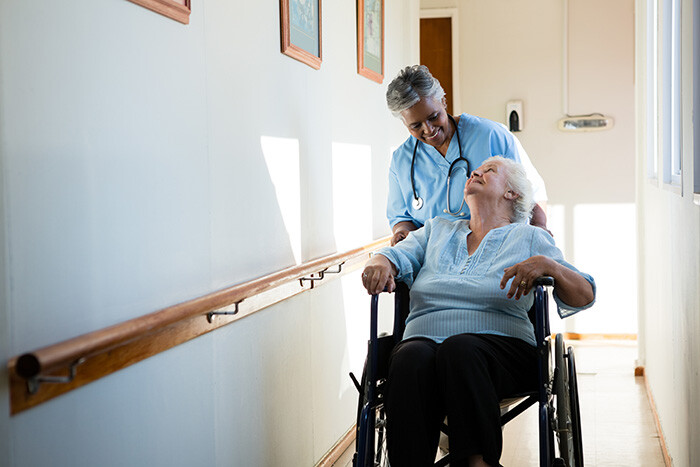Family and Caregiver Support
At Ohio Living Home Health & Hospice, we understand the challenges caregivers face and are dedicated to providing compassionate hospice care tailored to the needs of your loved ones. Our comprehensive services encompass physical, emotional, and spiritual support, ensuring comfort and dignity during life’s most delicate moments. With a commitment to personalized care and a team of experienced professionals, Ohio Living is here to support you and your family every step of the way.
Finding the right level of hospice care for your loved one
All Medicare-certified hospice care providers must offer four levels of care tailored to patient and caregiver needs. Those needs can influence the type of care a hospice provider delivers, so it is important to keep this in mind when choosing a provider for your loved one.
Your Ohio Living clinical care team will work with you and your loved one to determine the appropriate level of care for them, and will continue to monitor symptoms so their care can be adjusted when needed.
Routine Home Care
By far, the most common level of care is routine hospice care. This care can be provided in any setting, and includes regularly scheduled visits by the patient’s hospice physician, nurses, aides, social workers, chaplains and volunteers.
Inpatient Care
Additional care can be provided to control pain or other acute symptoms that cannot be addressed in any other setting. General inpatient care begins when a patient’s symptoms become uncontrolled. The goal is to improve symptoms with additional interventions and oversight that can only be provided in a Medicare-certified hospital or skilled nursing facility.
Continuous Care
Continuous care is provided up to 24 hours a day to manage pain and other acute symptoms. Services are provided by the hospice team and are intended to help terminally ill patients through a pain or symptom crisis at home. This care can be provided by any member of the hospice team.
Respite Care
Temporary relief is available to primary caregivers. Inpatient respite care is provided in the long-term care facility of the patient’s choice, and is available for a maximum of five consecutive days.
Hospice Myths
-
Does choosing hospice mean I'm giving up hope?
-
Not at all! Actually, hospice helps to continue hope: the hope of a quality of life, the hope of peace, the hope of serenity. At Ohio Living Home Health & Hospice, our goal is never to take away someone’s hope of another option to come. If there is something new to trial, in hopes of improving health status and changing the decline of the disease, we support that, and hospice can be revoked.
-
Is hospice only for cancer patients?
-
It is not. Hospice was first intended and used for cancer patients, but it is now available to any person with a limited life expectancy, with any disease process. This may be cardiac, lung disease, dementia, any disease that is progressing with no “cure” available.
-
Can I keep my primary care physician?
-
Yes! Hospice care covers the eligible disease process and its treatment. Being able to continue to see your primary care physician is allowed and continues to be covered by Medicare with your choice iof physician. The hospice team will stay in touch with your physician in order to report changes in your condition.
-
Does hospice require a Do Not Resuscitate (DNR) order?
-
Not with Ohio Living Home Health & Hospice.Some other providers may mandate this, but we choose to support patients as they work through this difficult time, and help them and families understand the process and ramifications of “full code” as the disease progresses.
-
Do hospice patients have to discontinue all medication?
-
They do not. Ohio Living Home Health & Hospice standard is to review the medications and monitor their benefit. We only discontinue medications as they become non-beneficial, or when the client is declining or unable to take the medication because of inability to swallow.

Learn the truth behind common misconceptions with our Myths about Hospice downloadable PDF.
Do Not Resuscitate can be a complicated topic. Let us help you break it down with our DNR Explanation downloadable PDF.
Find out how we support hospice patients' control over their own care with our Hospice is a Choice downloadable PDF.

Advanced Directives
Advanced directives are legal documents that outline your loved one's wishes regarding medical care in the event they are unable to communicate their decisions. At Ohio Living Home Health & Hospice, we encourage caregivers to discuss and complete these directives to ensure that their loved one's preferences are known and honored. Our team is available to guide you through the process, providing the information and support needed to make informed choices about end-of-life care.
- Living Will: Specifies the types of medical treatment your loved one wants or does not want if they become unable to communicate.
- Durable Power of Attorney for Healthcare: Appoints a trusted person to make healthcare decisions on your loved one's behalf if they are unable to do so.
- Do Not Resuscitate (DNR) Order: Instructs healthcare providers not to perform CPR if your loved one's breathing or heart stops.
- Physician Orders for Life-Sustaining Treatment (POLST): Provides detailed instructions about your loved one's preferences for medical interventions and treatments, typically used for those with serious illnesses.
Paying for Home Health and Hospice Services
Home health care at Ohio Living can be funded through various payment options, ensuring accessible and affordable services for your loved ones. Medicare often covers home health care for eligible patients who require intermittent skilled nursing care, physical therapy, or other therapies, provided certain conditions are met. Medicaid also offers coverage for qualified individuals, helping to manage the costs of in-home medical care and support services. Many private insurance plans include home health care benefits.
Hospice care also has several options to ensure your loved one receives the best care without financial stress. Medicare covers hospice care for eligible patients with a terminal illness and a life expectancy of six months or less, providing services such as medical care, pain management, and emotional and spiritual support. Additionally, Medicaid offers similar coverage for those who qualify. Many private insurance plans also include hospice benefits as well.
For those without insurance or limited financial resources, Ohio Living can assist in exploring other payment options or financial assistance programs to ensure that everyone has access to compassionate and quality care.


Palliative Medicine and Hospice: Know the Difference
People who are experiencing pain, shortness of breath, nausea, anxiety, depression, frequent hospitalizations or visits to the emergency department may benefit from palliative care, which can be provided at any stage in the illness, including during aggressive or curative treatments.
Ohio Living Palliative Medicine’s team is comprised of compassionate, experienced nurse practitioners and other specialists who work with you to provide relief for your patients who have a chronic disease and the need for pain or symptom management.
We offer your loved one:
- In-depth experience working with whole-person care that can relieve symptoms of a disease or disorder, regardless of whether it can be cured.
- A full range of services provided by one of our nurse practitioners, based on your patient’s needs and requests.
- Family meetings to discuss goals of care and to make treatment choices.
- A personalized treatment plan with goals specific to your patients’ needs, concerns, symptom management and relief from suffering.
- Coordination of care across health care services to maximize the quality of life along the continuum of the illness.